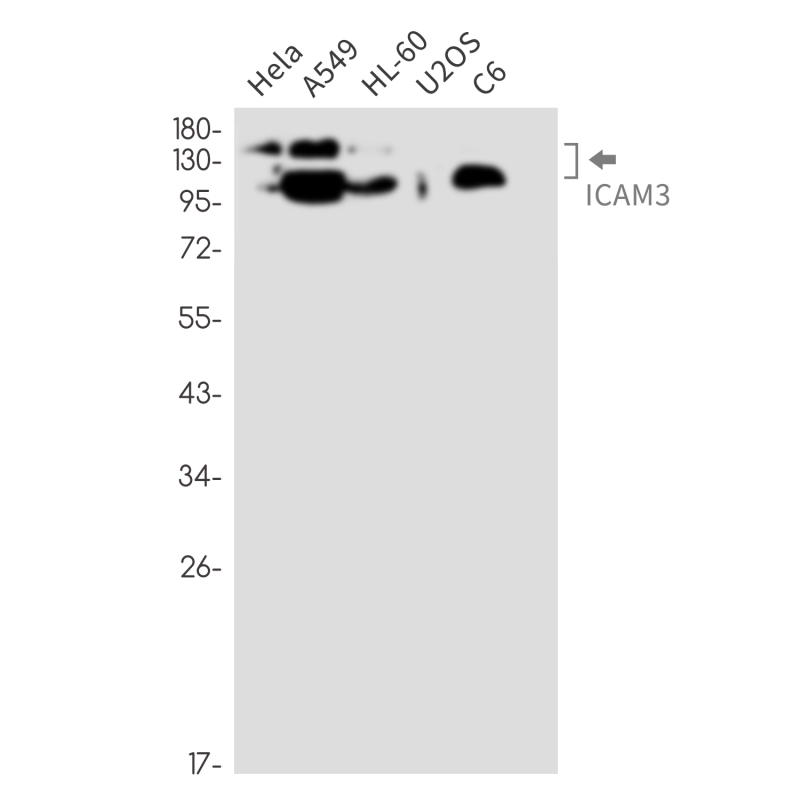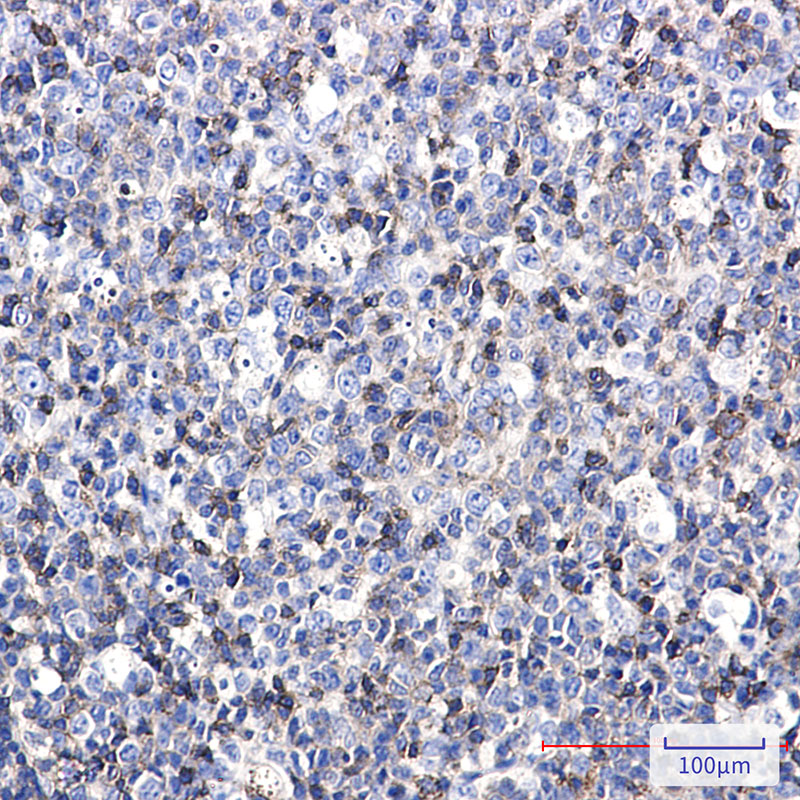

| WB | 1/500-1/1000 | Human,Mouse,Rat |
| IF | 1/20 | Human,Mouse,Rat |
| IHC | 1/50-1/100 | Human,Mouse,Rat |
| ICC | 技术咨询 | Human,Mouse,Rat |
| FCM | 咨询技术 | Human,Mouse,Rat |
| Elisa | 咨询技术 | Human,Mouse,Rat |
| Aliases | CD50; CDW50; ICAM-R |
| Entrez GeneID | 3385 |
| WB Predicted band size | Calculated MW: 60 kDa; Observed MW: 110-160 kDa |
| Host/Isotype | Rabbit IgG |
| Antibody Type | Primary antibody |
| Storage | Store at 4°C short term. Aliquot and store at -20°C long term. Avoid freeze/thaw cycles. |
| Species Reactivity | Human,Rat |
| Immunogen | A synthetic peptide of human ICAM3 |
| Formulation | Purified antibody in TBS with 0.05% sodium azide,0.05%BSA and 50% glycerol. |
+ +
以下是关于ICAM3抗体的3篇示例文献(内容为模拟创作,仅供参考):
---
1. **文献名称**:*ICAM-3 binds to LFA-1 and regulates antigen-induced T-cell activation*
**作者**:Hernández-Caselles, T., et al.
**摘要**:研究揭示了ICAM3与LFA-1的相互作用在T细胞活化中的关键作用,通过特异性抗体阻断实验证实ICAM3抗体可抑制T细胞与抗原呈递细胞的黏附,从而调控免疫突触形成。
2. **文献名称**:*ICAM-3 facilitates HIV-1 infection by stabilizing virological synapses*
**作者**:Hioe, C.E., et al.
**摘要**:该文献报道了ICAM3抗体可干扰HIV病毒与宿主细胞间“病毒学突触”的形成,降低病毒传播效率,提示ICAM3可能是抗HIV治疗的潜在靶点。
3. **文献名称**:*Structural insights into ICAM-3 recognition by monoclonal antibodies*
**作者**:Simmons, D.L., et al.
**摘要**:通过X射线晶体学解析了ICAM3与其单克隆抗体的复合物结构,揭示了抗体结合的表位区域,为开发靶向ICAM3的免疫疗法提供结构基础。
---
如需实际文献,建议通过PubMed或Google Scholar搜索关键词“ICAM3 antibody”或结合具体研究场景筛选。
ICAM-3 (Intercellular Adhesion Molecule 3), also known as CD50. is a cell surface glycoprotein belonging to the immunoglobulin superfamily. Primarily expressed on leukocytes, including T cells, neutrophils, and dendritic cells, it plays a critical role in immune cell interactions by mediating adhesion and signaling. As a ligand for lymphocyte function-associated antigen 1 (LFA-1), ICAM-3 facilitates leukocyte adhesion to endothelial cells, antigen presentation, and immunological synapse formation during T-cell activation. Its constitutive expression on resting leukocytes distinguishes it from ICAM-1. which is inducible under inflammatory conditions.
ICAM-3 antibodies are essential tools in immunological research and diagnostics. They are used to study leukocyte trafficking, immune cell activation, and cell-cell communication in diseases like chronic inflammation, autoimmune disorders, and cancer. Therapeutic applications are also explored, particularly in modulating immune responses or blocking viral entry, as ICAM-3 has been implicated in HIV-1 infection through interactions with viral envelope proteins. Additionally, anti-ICAM-3 antibodies aid in characterizing leukocyte subsets via flow cytometry. Recent studies investigate their potential in targeting ICAM-3-overexpressing tumors or regulating aberrant immune activity, highlighting their dual role as research reagents and candidates for immunotherapy development.
×